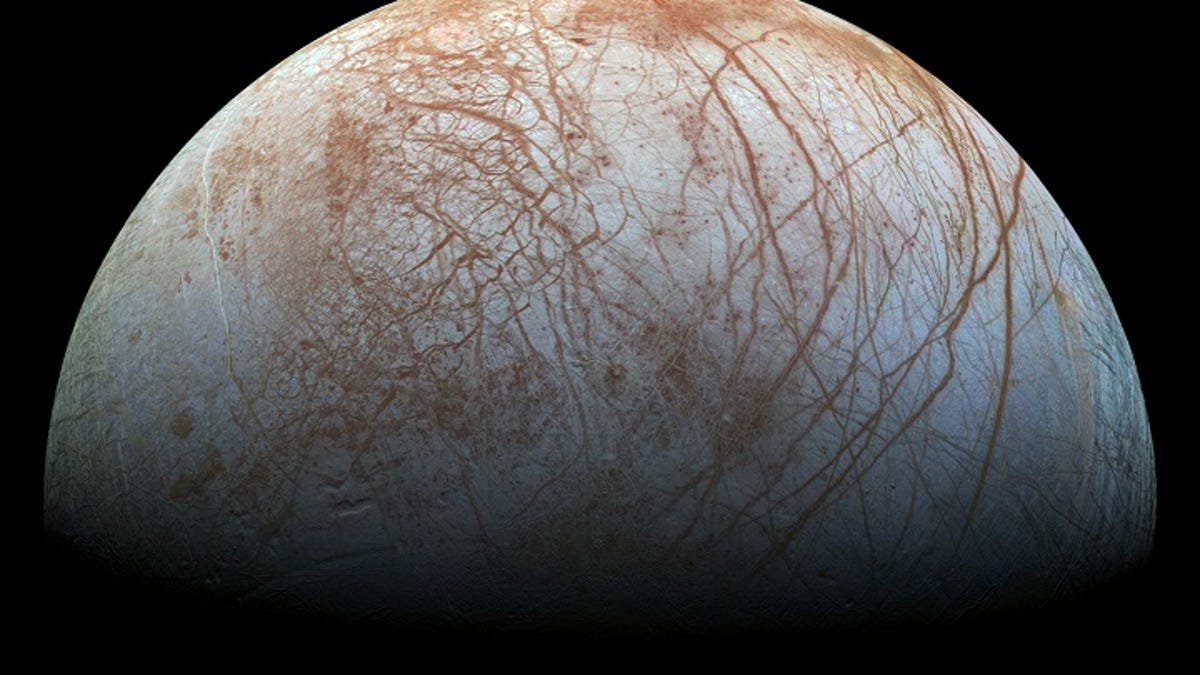Water plumes could be making it rain on Jupiter moon Europa
NASA's Hubble telescope may have spotted water plumes. That could make it much easier to sample Europa's supposed subsurface ocean, where we just might find the building blocks for life.

NASA has news on perhaps the spookiest place for scuba diving in the solar system. The space agency said Monday the Hubble space telescope has imaged what might be water vapor plumes erupting off the surface of Jupiter's moon Europa.
If the plumes are real and raining down on the surface, scientists say, it could be easier to access material that was once in the moon's subsurface ocean.
"Europa's ocean is considered to be one of the most promising places that could potentially harbor life in the solar system," Geoff Yoder, acting associate administrator for NASA's Science Mission Directorate, said in a release. "These plumes, if they do indeed exist, may provide another way to sample Europa's subsurface."
The plumes are estimated to rise about 125 miles (about 200 kilometers) from the icy surface. If some sort of material then rains back down on Europa, it would provide a tantalizing invitation for a mission to gather samples of what could be one of the more likely places in the solar system to host the building blocks of life beyond Earth.
This is a pretty big deal because it means we could possibly get at that hidden ocean without having to drill through miles of ice.
"Life, as we know it, requires liquid water, and Europa's on NASA's hit list because it is one of the most likely places to find water in our solar system," Rice University planetary geophysicist Adrian Lenardic said in a statement. "If you find a place with liquid water, the potential that it could host life, be it probably little bacteria at this point in time, increases. And that's the excitement. That's the draw."
The astronomers behind Monday's news stressed they were working at the limits of Hubble's capabilities and are not claiming to have proven that the plumes do exist. Rather, they are presenting new evidence. A few years ago, the Hubble space telescope also spotted what looked to be plumes of water vapor at Europa's south pole.
"Neither Hubble's cameras nor the instruments from other spacecraft are going to see actual evidence of life on the surface," Lenardic said.
The team used Hubble to observe Europa passing in front of Jupiter with the goal of looking for a silhouette of a potential atmosphere around the moon. On three out of 10 times that these observations were made, they noticed what could be plumes erupting.
So far, the observations suggest that the eruption of the plumes is highly variable, which might explain why they are not seen consistently. A paper detailing the new findings will be published in The Astrophysical Journal on Sept. 29, but a draft can be viewed here (PDF).
If confirmed, Europa would be the second world in our solar system to show off its own geysers. The Cassini spacecraft has actually flown through similar plumes at Saturn's own frozen moon, Enceladus.
For a few decades now, Europa has offered perhaps the most promise of potential for life beyond Earth in the solar system. In the 1990s the Galileo mission collected evidence that a hidden saltwater ocean beneath the moon's icy shell could be warmed by tidal heating and interacting with a rocky sea floor to provide the chemistry needed for life to emerge.
Europa has even crossed over from generating enthusiasm among the space nerd community to captivate a wider audience via one of the more realistic space sci-fi movies in recent years, "Europa Report."
Unlike the manned mission to Europa from that film, NASA is looking to send an unmanned mission to Jupiter that will make a number of flybys of Europa. This is probably a good plan of action considering Europa tends to get nuked often by Jupiter's radiation belt.

